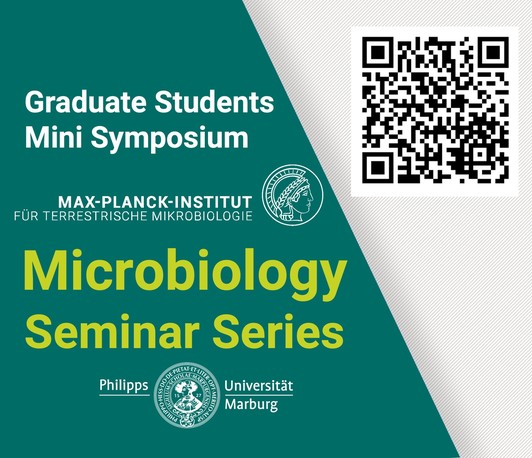Graduate Students Mini Symposium IX-2023
Graduate Students Mini-Symposium
- Date: Oct 16, 2023
- Time: 01:15 PM (Local Time Germany)
- Location: MPI for Terrestrial Microbiology
- Room: Lecture Hall / Hybrid
- Host: IMPRS
- Contact: imprs@mpi-marburg.mpg.de

13:15 h Daniela Vidaurre, AG Bode
Molecular regulation of the symbiosis
between entomopathogenic nematodes and their bacterial symbionts
Photorhabdus and Xenorhabdus
engage in a mutualistic symbiotic relationship with entomopathogenic nematodes
(EPNs) belonging to the genera Heterorhabditis
and Steinernema, respectively. The
aim of this project was to investigate the influence of natural products (NPs)
synthesized by the bacterial symbiont on nematode development. Comparative experiments were conducted
in S. diaprepesi using wild-type (WT)
and mutant strains of X. doucetiae
deficient in NP synthesis. These strains included those lacking the global
post-transcriptional regulator protein Hfq, a phosphopantetheinyl transferase
(PPTase), deletions and promoter exchange related to tryptophan/phenylalanine
decarboxylase (DC) linked to acyl amide biosynthesis, and promoter exchange
associated with gene clusters responsible for NP production. Based on the
results obtained, it has been determined that amines/amides and protegomycin
are essential for the proper development of EPNs. Conversely, excessive
production of GameXPeptide has a detrimental effect.
13:45 h Leonard Präve, AG Bode
Investigation of the Odilorhabdin biosynthetic gene cluster using NRPS engineering
Odilorhabdin, a peptide produced in entomopathogenic bacteria of the genera Xenorhabdus and Photorhabdus, was recently identified.[1] Its antibiotic activity against Gram-negative and Gram-positive bacteria inspired the development of its synthetic derivative NOSO-502, which holds huge potential in application as a new clinical drug.[2] While the mechanism and target of this drug was broadly investigated, the biosynthesis pathway encoded by the odilorhabdin biosynthetic gene cluster (BGC) remained poorly understood. Here we describe the utilization of NRPS engineering to elucidate the role of several non-ribosomal synthetases (NRPS) domains as well as three additional hydroxylases and one deacylase involved in the synthesis of odilorhabdin. Therefore, individual NRPS modules of the odilorhabdin synthetase were assembled to well-studied or artificial NRPS to investigate the biosynthesis of respective peptides in vivo in E. coli. This work demonstrated the application of NRPS engineering as a tool to mechanistically elucidate large or toxic NRPS. Besides obtaining mechanistic knowledge about the biosynthesis, these insights might provide a basis to generate novel odilorhabdin analogs via NRPS engineering in the future.